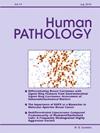Expression evaluated by digital image analysis techniques of PRAME more than MCM6 is associated with poor prognosis in neuroblastoma: A pilot study with 84 cases
IF 2.7
2区 医学
Q2 PATHOLOGY
引用次数: 0
Abstract
Neuroblastoma is a common childhood tumor originating from neural crest progenitors with variable clinical behavior. Despite improved overall survival, factors such as stage, histoprognosis, MYCN status, and age still influence outcome. MCM6 regulates DNA replication and contributes to cancer progression. PRAME, first identified in melanoma, also acts on cell replication, epithelial-mesenchymal transition, and cell migration and has been associated with poor outcomes in several cancers, including neuroblastoma, using molecular biology techniques. The study aims to investigate MCM6 and PRAME expression and prognostic roles in neuroblastoma.
A retrospective study was conducted, which included data of 84 patients with neuroblastoma diagnosed between 2000 and 2022, sourced from the pediatric tumor registry. Patient's characteristics and prognostic tumor factors were collected. Expression of MCM6 and PRAME proteins was evaluated using digital image analysis techniques. Univariate and multivariate analyses were performed using Cox regression to assess the impact of protein expression on survival and their associations with these prognostic factors.
A total of 84 children diagnosed with neuroblastoma were included. MCM6 and PRAME were associated with unfavorable histologies (p = 0.03). PRAME was associated with bone marrow metastases (p < 0.01), high mitotic-karyorrhectic index (p = 0.04), and poor histoprognosis (p < 0.01).
PRAME and MCM6 expression was correlated with several neuroblastoma prognostic factors. PRAME was significantly (p = 0.05) associated with poor event-free survival (EFS) and not significantly (p = 0.08) associated with overall survival (OS). Although statistical significance was not reached in multivariate analysis, the trends strongly suggested that the overexpression of MCM6 and PRAME was correlated with decreased survival.
84例神经母细胞瘤中,数字图像分析技术评估的prame大于MCM6与预后不良相关:一项初步研究。
神经母细胞瘤是一种常见的儿童肿瘤,起源于神经嵴祖细胞,临床表现多变。尽管总生存率提高,但分期、组织预后、MYCN状态和年龄等因素仍影响预后。MCM6调节DNA复制并促进癌症进展。PRAME首先在黑色素瘤中被发现,它也作用于细胞复制、上皮-间质转化和细胞迁移,并通过分子生物学技术与包括神经母细胞瘤在内的几种癌症的不良预后相关。本研究旨在探讨MCM6和PRAME在神经母细胞瘤中的表达及其预后作用。进行了一项回顾性研究,其中包括2000年至2022年间诊断为神经母细胞瘤的84例患者的数据,这些数据来自儿科肿瘤登记处。收集患者特征及预后肿瘤因素。使用数字图像分析技术评估MCM6和PRAME蛋白的表达。使用Cox回归进行单因素和多因素分析,以评估蛋白质表达对生存的影响及其与这些预后因素的关联。共有84名被诊断为神经母细胞瘤的儿童被纳入研究。MCM6和PRAME与不良组织学相关(p=0.03)。PRAME与骨髓转移相关(p
本文章由计算机程序翻译,如有差异,请以英文原文为准。
求助全文
约1分钟内获得全文
求助全文
来源期刊

Human pathology
医学-病理学
CiteScore
5.30
自引率
6.10%
发文量
206
审稿时长
21 days
期刊介绍:
Human Pathology is designed to bring information of clinicopathologic significance to human disease to the laboratory and clinical physician. It presents information drawn from morphologic and clinical laboratory studies with direct relevance to the understanding of human diseases. Papers published concern morphologic and clinicopathologic observations, reviews of diseases, analyses of problems in pathology, significant collections of case material and advances in concepts or techniques of value in the analysis and diagnosis of disease. Theoretical and experimental pathology and molecular biology pertinent to human disease are included. This critical journal is well illustrated with exceptional reproductions of photomicrographs and microscopic anatomy.
 求助内容:
求助内容: 应助结果提醒方式:
应助结果提醒方式:


